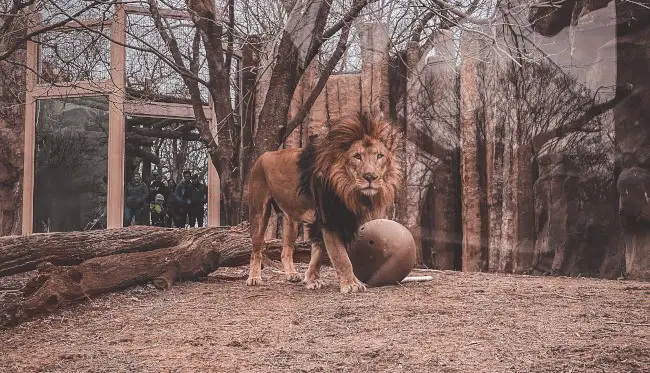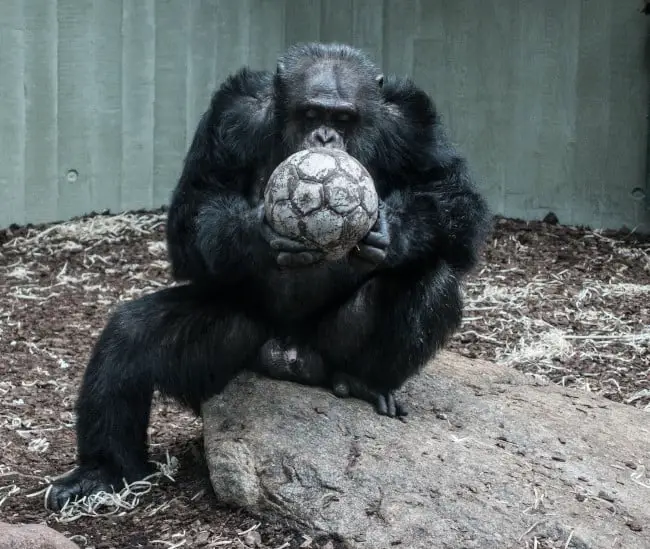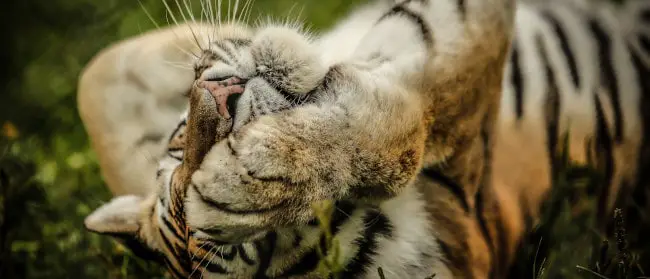Environmental enrichment is a tool to promote more natural behaviour and stimulate physical and mental stimulation to an animal. In zoos, we try to provide the best environment and the best care possible: A well-designed enclosure that fulfils the needs of the animal. Animal training to reduce stress and frustration on daily husbandry activities or medical care. But also create a challenging environment to shape possibilities for an animal to perform its natural behaviours. We all know the old barren zoos of the past, where you saw a lonely carnivore in an understimulating environment continuously pacing. In the present day, this is seldomly seen anymore. But sometimes, abnormal behaviour develops, and in the worst-case scenario, an animal starts to show stereotypes. And what then? Can environmental enrichment play a role to tackle behavioural problems and reduce stereotypic behaviours?

Can environmental enrichment tackle stereotypic behaviour? Several meta-analyses have found that enrichment effectively decreases stereotypic behaviour, with 90% of studies found by Shyne (2006) showing a significant effect of enrichment, reducing stereotypic behaviours compared to baseline conditions.
So we can conclude that environmental enrichment is a valid, and also an effective, tool to reduce undesired behaviour. But to combat for the reduction or absence of abnormal and stereotypic behaviour, it is more than just to provide many different kinds of environmental enrichment. To better understand how to approach such a behavioural problem with the use of enrichment, we first have to understand what stereotypic behaviour is and how it can develop. However, before we break down this question, it is a better practice to prevent behavioural problems.

Better prevent behavioural problems than to cure it
Although we know that it is easier to prevent a (welfare) problem than curing it, some institutions are reactive to animal welfare problems. In still too many cases, zoos have a great motivator to implement environmental enrichment when an animal welfare problem appears. For instance, when you see locomotor stereotypy (e.g. pacing) or self-injurious behaviour (e.g. fur plucking), they start implementing enrichment. When using this strategy, my most concern is that of the many non-visual welfare problems are missed this way. It would be better to use a proactive enrichment strategy to prevent that such behavioural problems occur. With this strategy, you assess what welfare and behavioural requirements a captive animal needs and will use environmental enrichment to provide it. An animal has 24 hours to spend in a day. The behavioural void that is created by living in captivity, and especially in an understimulating environment with little to occupy time, an animal must find ways in which to fill this void. In another way, when an animal has a strong behavioural need to perform a certain behaviour but has no possibility to do so, will be frustrated and suffer. Other behaviours will fill this time to cope with the situation. So, therefore, you must give opportunities for animals to perform as many as possible behaviours to prevent the development of abnormal and stereotypic behaviour. This proactive enrichment planning is indispensable for current husbandry practices. Now, let’s have a closer look at what stereotypic behaviour is before we can consider how to tackle it.

What is stereotypic behaviour?
Turner (1999) describes behaviour as stereotypic when it involves repetition, rigidity and invariance as well as a tendency to be inappropriate. Classic examples are pacing of carnivores, tongue-playing by giraffes and fur-plucking by rodents or primates. Stereotypes can be caused by frustration, attempts to cope with suboptimal environments or a dysfunction of the central nervous system. Whereas the latter is not much to do about it, the first two causes are the ones that need attention. Stereotypes are very complex, and it can be difficult to understand fully. But what is more important is what caused this stereotypic behaviour?

What causes the stereotypic behaviour?
When we discover the development of stereotypic behaviours we like to solve it as soon as possible, however, solving the problem can only be done by first assessing the problem. And that is by determining the root cause of why the animal does this behaviour. The first step is a full description of the environment of the animal and the circumstances under which this behaviour occurs. Many times, and with best intentions, the typical response to such problems is to either block the behaviour (e.g. block the route of locomotor stereotypes) or to provide many kinds of environmental enrichment which not take away the cause of the undesired behaviour. For example, a tiger has recently started to pace in his enclosure. You can block the route it repetitively walks, but this will often result in walking another repetitive path or result in frustration. The cause of the problem is still there, even when you not see the behaviour anymore. Instead, you might add additional enrichment to provide stimulation and alleviate boredom. If you have luck, and it was the cause of the pacing behaviour, enrichment may effectively reduce the undesired behaviour. However, it is often the case that the cause is not so straightforward. The pacing behaviour may be started because of ambient noise, a new inhabitant, the onset of the breeding season, increased crowd size, or a combination of these or completely another factor. In that case, the enrichment effort may not result in reducing this behaviour and not alleviate the underlying concern that drives the stereotypic behaviour. Furthermore, stereotypies may not even reflect the current condition but remain of past experiences. I’ve seen elephants move from understimulated environments to environments where there is much more stimulation, and still, after many years, shows stereotypic behaviours. In that case, the behaviour has become a habit for the animal. So, the sooner the problem is addressed, the more likely it is that enrichment will be effective. Once stereotypic behaviour has been established and become a habit, they become (almost) irreversible. Stereotypes are a coping mechanism for the environmental stressor, and it is self-reinforcing, which cause its perseverance.

The following questions are a good starting point to determine if, and what is causing the stereotypic behaviour (from: EAZA Animal Training Working Group, 2016). It is critical to determine if the behaviour is reinforced in any way and therefore serves a function to the animal, or has become established and is a habit.
- Are there identifiable triggers/antecedents for the behaviour?
- Can you identify reinforcers for the behaviours?
- Is there body language that correlates to the anticipation of the delivery of desired consequences? (access to preferred conspecifics or opportunities to mate, etc.)
- Is there body language that correlates to vigilance or anticipation of undesired consequences? (fear responses-anticipation of undesired consequences, the anticipation of desired consequences?
- Is the behaviour on an intermittent schedule of reinforcement?
- Is there variance in the patterns of the behaviour?
- Is there body language indicative of pain?
- Has the animal been evaluated for pain/health issues?
- Could the pain/health issues be intermittent? Cyclical? Related to reproductive states?
- Does the animal have the opportunity to express a full range of species-typical movement/energy expenditure in a 24-hour period? Is this energy expenditure opportunity age-appropriate?
- Is the repetitive behaviour considered undesired due to human’s perception of what the animal should be doing?
- Could the behaviour be learned from a neighbouring animal?
- Is there a genetic predisposition for repetitive behaviour?
- Does the animal have a history of early weaning followed by social isolation?

How can enrichment tackle stereotypic behaviours?
Enrichment can only tackle stereotypic behaviours when it removes the root cause of these behaviours. It is vital to treat abnormal behaviour problems while the original cause is still the source of the problem. Again, too often facilities focus only on the effects of the behaviour, the visible part of the behaviour, and not on the causation. When knowing the cause, you can formulate an enrichment strategy that suits its causation. When implementing the enrichment, you should evaluate periodically your efforts to see if the stereotypic behaviour reduces. When offering enrichment to the animal, it is essential to provide it before the presentation of the stereotypic behaviour, and not at the moment the animal is performing such behaviour. This way, you avoid reinforcing this behaviour, and consequently not be more prevalent.

Enrichment is a powerful tool!
I want to finish this blog with a request; Please, enrichment can be a powerful tool to manage the animals in your care, but use it in a proactive manner to stimulate the best species-appropriate behaviours, and so to prevent undesired behaviours in the future. If you have any queries, please send me a message or leave a comment below. And I can unquestionably recommend reading the resources below, too, to get a better understanding of abnormal and stereotypic behaviour!
Further reading
- Can’t stop, won’t stop: is stereotypy a reliable animal welfare indicator? (article)
- Environmental Enrichment as a Strategy for Mitigating Stereotypies in Zoo Animals: a Literature Review and Meta-analysis (article)
- Why and how should we use environmental enrichment to tackle stereotypic behaviour? (article)
- Stereotypies: a critical review (article)
- The effect of extra feed supply on stereotypic behaviour in Asian elephants (article)
- Why do polar bears and other captive carnivores perform stereotypic behavior? (article)
- The use of positive reinforcement training to reduce stereotypic behavior in rhesus macaques (article)
- Attitudes to Animals: Views in Animal Welfare (book)
- Environmental Enrichment for Captive Animals (book)
Disclaimer: To be very clear; photos used in this article do not in any way reflect that these institutions have bad welfare management or accused as detrimentally keeping their animals.
Share this page!